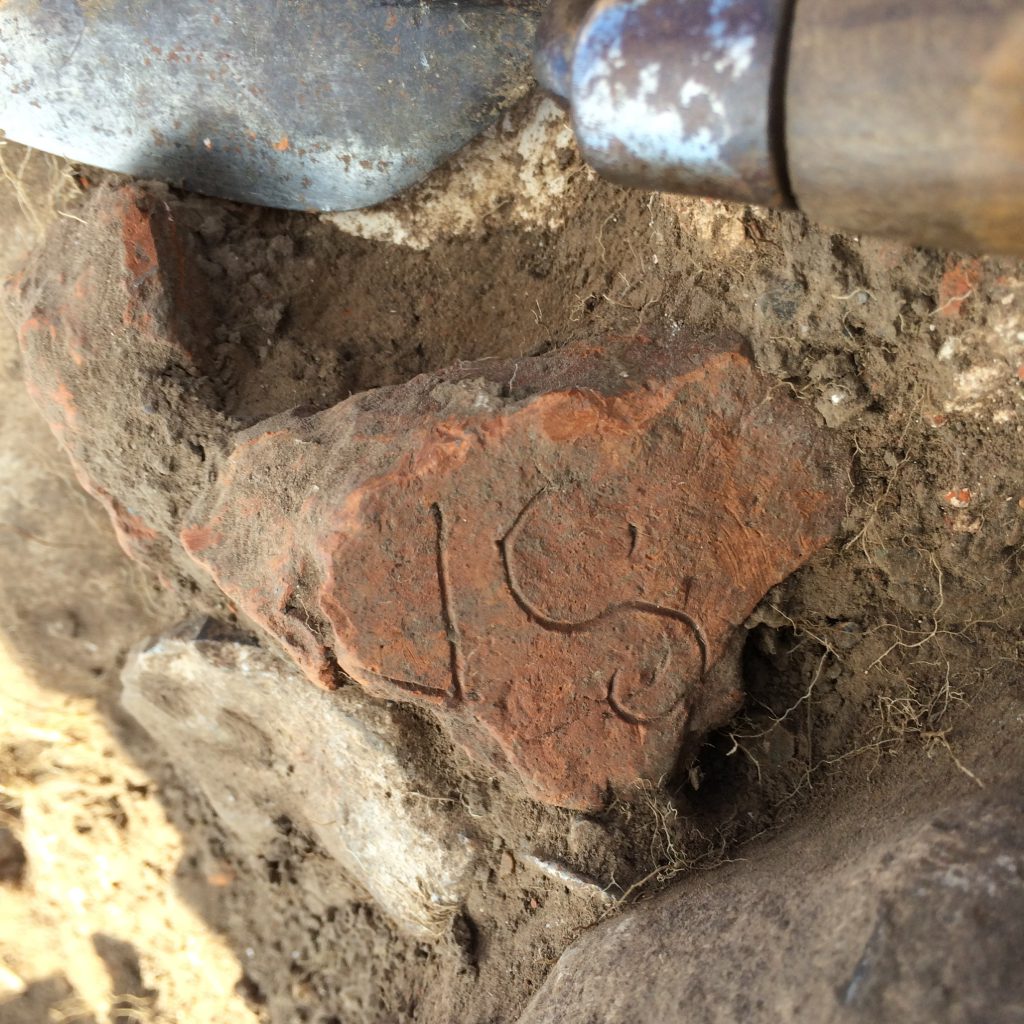September 14, 2016, by Will Leveritt
Finding Roman writing at Bourne Park, Kent
Text by Alex Mullen
On Thursday, the same day the European Research Council announced that my 5-year project The Latinization of the North-western Roman Provinces: Sociolinguistics, Epigraphy and Archaeology will be funded, the archaeological site I’ve been co-directing since 2013 offered up its first bit of writing. It isn’t going to make the headlines anywhere but I think it is rather exciting.

Letters on CBM from the Roman villa at Bourne Park, Bishopsbourne, Kent. Photo courtesy of Lloyd Bosworth.
Following a total of 5 years’ geophysical work with students from the Universities of Cambridge and Oxford across Bourne Park, Bishopsbourne, Kent, we are finally excavating a small part of the Roman villa in the valley. This is under the aegis of the Canterbury Hinterland Project, directed by Lacey Wallace. Up until now our focus had been on broad landscape survey and trying to understand better the nature and development of East Kent in the pre-Roman, Roman and post-Roman periods. Bourne Park is the first of a series of sites we have investigated and has kept us busy with its complex landscape of Bronze Age to World War features. This year we have teamed up with Steve Willis of the University of Kent and his students and are excavating in order to test hypotheses generated through our previous geophysical survey (gradiometry, Ground-Penetrating-Radar, and electrical resistance survey; see https://blogs.kent.ac.uk/bourneroman/ for the dig diary).
So far, as always, the two trenches are throwing up more questions than answers, but what we know for sure is that it is definitely a Roman villa (definitive proof for those doubters who thought it could be cricket pavilion… phew!). On Thursday I was called to look in Trench A: some writing had been found. As I rushed over my mind was racing with wishful thinking: could it be a cache of writing tablets from the villa’s filing cabinets covered in wonderful Roman cursive? Or perhaps a dedication stone with dates and names of the villa’s owners? In the end it was two letters on a bit of CBM (ceramic building material). It almost certainly says -VS, or possibly SA- (with the crossbar of the A missing) and is in Latin, though it may be part of a Celtic name. The letters are interesting because they tell us that this site represents a literate environment. Until I’ve been able to have a closer look, I can’t be sure, but it looks as if this writing has been incised into a tile ante cocturam. This, of course, would mean that it is likely that this is evidence for literacy on the part of someone in the tile manufacturing business (perhaps not as unexpected as you might think – check out the graffiti from La Graufesenque, south-western France, for a bunch of literate potters) and does not provide evidence that the villa owners could write, but it does tell us that they were living somewhere writing was reaching, and those who moved the tile around and built the villa might have seen it.
Not many inscribed tiles from Roman Britain have been published: there are over 200 examples in The Roman Inscriptions of Britain Vol. II.5, many fewer than the graffiti on samian ware in Vol II.7, for example, but my hunch is that graffiti on CBM has traditionally been unlikely to have been carefully recovered, cleaned and deemed worthy of publication so we may only have published a very small percentage. My archaeologically informed, social historian’s approach to sociolinguistics and epigraphy in the ancient world means that in understanding the spread of (different varieties of) Latin, literacy, bi- and multilingualism and how they correlate with a range of other social variables, every little scrap counts and sometimes the scrappy bits of graffiti turn out to be the most interesting. I’ll proudly add these letters from Bourne Park to the project GIS when the Latinization project gets underway in the New Year.

Many thanks for this. I am just starting a MA Classical Studies with the OU and, I hope you don’t mind, but just posted a link to this on our Introductory Forum as an example of interdisciplinary study using fragments of epigraphy through archaeology and the potential impact it has for our understanding of linguistics, literacy and Romanisation.
Best regards.
Of course! Glad it is of use